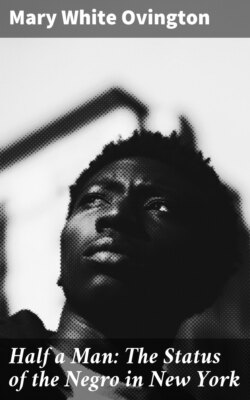Half a Man: The Status of the Negro in New York

Реклама. ООО «ЛитРес», ИНН: 7719571260.
Оглавление
Mary White Ovington. Half a Man: The Status of the Negro in New York
Half a Man: The Status of the Negro in New York
Table of Contents
FOREWORD
Footnote
HALF A MAN
INTRODUCTION
CHAPTER I "Up from Slavery"
Footnote
CHAPTER II. Where the Negro Lives
Footnote
CHAPTER III. The Child of the Tenement
Footnote
CHAPTER IV. Earning a Living—Manual Labor and the Trades
Footnote
CHAPTER V. Earning a Living—Business and the Professions
Footnote
CHAPTER VI. The Colored Woman as a Bread Winner
Footnote
CHAPTER VII. Rich and Poor
Footnote
CHAPTER VIII. The Negro and the Municipality
Footnote
CHAPTER IX. Conclusion
Footnote
APPENDIX
INDEX
Отрывок из книги
Mary White Ovington
Published by Good Press, 2021
.....
The city grew rapidly after 1875, and the colored society, the little group that had attained to modest means and education, bought homes, chiefly in Brooklyn, where land was easier to secure than in Manhattan, and strove to enlarge the opportunities for those who were to come after them. Color prejudice had waned, and they often met with especial consideration because of their race. Had they been white they would have slipped into the population and been lost, as happened to the Germans and the Irish, who had been their competitors. As it was, they formed a society apart from the rest of the city, meeting it occasionally in work or through the friendship of children, who, left to themselves, know no race. They had battled against prejudice and had won their rights as citizens.
As we look at the life of a segregated people, however, we see that we tend always to regard not the individual but the group. The Negro is a man in Europe, because there he is an individual, standing or falling by his own merits. But in America, even in so cosmopolitan a city as New York, he is judged, not by his own achievements, but by the achievements of every other New York black man. So we will leave these able colored Americans, who won much both for themselves and for their race, and turn to the mass of the Negroes, the toiling poor, who dwell in our tenements today.
.....